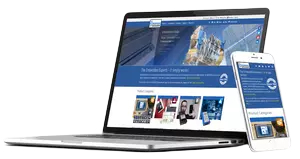TYPO3 Upgrade of the SEGGER Corporate Website
The original website was developed in-house based on TYPO3 7, and continued on-premises operation was desired. Marketing Factory was brought in as a TYPO3 expert to upgrade to a current version and optimise continued in-house maintenance with more modern workflows. Individual features of the website (e.g. building the complex navigation system or feedback forms) still had to be integrated into TYPO3.

| Client | SEGGER Microcontroller GmbH |
|---|---|
Project duration | 2019–2020 |
Discover the project from the perspective of:
CMS technology
The corporate website was updated from TYPO3 version 7.6 to version 9.5. The website’s extensive content was migrated, and the system environment and processes were modernised for further in-house operation. Simplifying the content management processes was one of the key areas of focus.
CMS - Technology
Upgrading the corporate website from TYPO3 version 7.6 to version 9.5 simplified the extremely complex content structure and migrated it via automated processes.
Search technology
The site search is based on the Solr search technology, which indexes the large product range and allows it to be searched through. A suggest function proposes search terms to visitors as soon as they have typed in the initial letters. This is particularly beneficial when considering the large number of technical product designations, as the top results are displayed with exact designations. Typing errors are remedied by suggested corrections on the search results page.
Search technology
Once again in this project, we turned to Solr search technology for a powerful site search function. The wide range of product and content pages can thus be effortlessly indexed and searched to provide website visitors with the information they need quickly and easily.
SEO/SEA actions
Upgrading to TYPO3 9.5 made it easier for the content managers to maintain SEO-relevant data. We also put in place an option to create structured data easily (schema.org). The strongly improved performance of the website how guarantees improved potential ranking.
SEO/SEA actions
The Yoast SEO extension for TYPO3 made it easier for the content managers to maintain SEO-relevant data.
Other backend and frontend technologies
One of the key objectives of this project was to improve site performance. Faster page loading times were achieved through an improved server architecture and more modern software components, as well as by reducing unnecessary frontend interactions (JavaScript layouts). The amount of data transferred was greatly reduced.
The content management workflow was improved, requiring less expertise and decision-making on their part: website maintenance was streamlined by simplifying and standardising the backend layouts and reducing the possible content elements and their layout versions for the frontend.
Other backend and frontend technologies
Site performance was improved by a number of measures. The Bootstrap package, a more powerful and future-proof theme, replaced the original theme. The layout scripts in JS Refactoring were removed and replaced by HTML/CSS solutions. Caching with Varnish and faster content delivery via a global CDN reduce page loading times. Images are output in the modern WebP web format, and native lazy loading for images in modern browsers with a fallback solution for IE11 ensures that content is displayed faster.
This has considerably improved the content management workflow. All the previously dispersed product information is now linked directly to the product page in the database. Menus and asset links are automatically generated from the page information. Syntax highlighting for the numerous code examples is done with the fs-code-snippet extension. Descriptive IDs for content elements are used to facilitate linking jump labels.
Custom Solutions
The corporate site contains many hundreds of pages on multiple levels. Its extensive navigation was technically reconfigured to sensibly position the key topics in the main navigation and present them with visual appeal to optimise website performance. There is also additional sub-page navigation that guides website visitors optimally to appropriate topics and thus further enhances the user experience (UX).
Custom Solutions
We developed a solution for the complex multi-level navigation, previously rendered from static HTML for performance reasons, which loads parts of the lower navigation levels once the page has become visible in the frontend.
Content Migrator
The frontend layout was to remain unchanged. But changing the Bootstrap extension necessitated migrating the content data into a completely new database format. This migration could only be solved over a relatively long period of time due to the extremely extensive and complex content.
Content Migrator
The frontend layout was to remain unchanged. But changing the Bootstrap extension necessitated migrating the content data into a completely new database format. This migration could only be solved over a relatively long period of time due to the extremely extensive and complex content. The method selected was to develop an additional, multi-level content migrator. The migrator was capable of continuously transferring the current content data to the new structure at the press of a button when the system was live. This avoided an extremely long content freeze during working hours and the intermediate results could be checked again and again on the different types of page and content.
